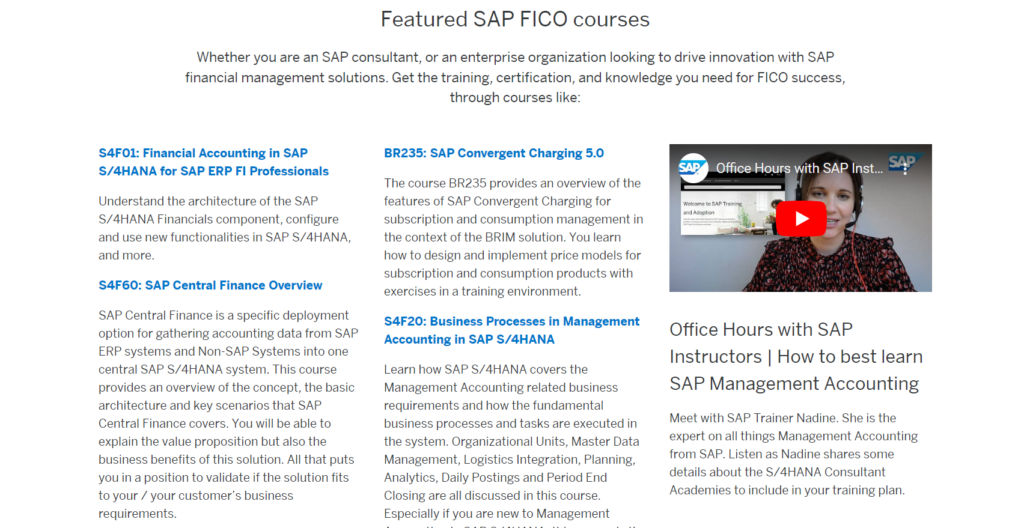SAP’s FICO technology is quickly becoming a leader in the world of business management software. With its ability to help companies increase organisational efficiency and automate financial processes, SAP’s FICO technology has become a valuable asset for businesses of all sizes. It’s no wonder why so many organisations are investing in this powerful enterprise resource planning (ERP) system. But how can you unlock the magic behind this advanced technology?
SAP’s FICO Technology
SAP’s FICO technology is a powerful tool that provides businesses with financial accounting and controlling capabilities. The software integrates financials, materials management, sales and distribution, production planning, project management, and human resources modules to create a comprehensive financial solution. One of the key benefits of using SAP’s FICO technology is its ability to streamline business processes by automating tasks such as payment processing and bank reconciliation.
With SAP’s FICO technology, businesses can also gain real-time insight into their financial performance through the use of dashboards that display key metrics such as cash flow and profitability. Additionally, the system has built-in controls that help ensure compliance with regulatory requirements such as GAAP or IFRS. This helps organisations mitigate risks associated with errors or fraud.
Overall, SAP’s FICO technology offers many benefits for businesses looking to improve their financial operations. By streamlining processes and providing real-time insights into performance metrics while ensuring compliance with regulations, companies can operate more efficiently and make better-informed decisions about their finances.
Want to gain knowledge on SAP IBP? Then visit here to learn SAP IBP Training!
What Is FICO?
FICO stands for Fair Isaac Corporation, which is a company that provides credit scoring services. FICO scores are used by lenders to determine a borrower’s creditworthiness and the likelihood of them paying back loans on time. The scores range from 300 to 850, with higher scores being better.
SAP’s FICO technology is a comprehensive financial management solution designed to help businesses manage their finances effectively. It integrates accounting, billing, financial planning, and reporting functions into one unified platform. With SAP’s FICO technology, businesses can streamline their financial processes and gain real-time insights into their operations.

In conclusion, FICO plays an important role in determining an individual’s creditworthiness while SAP’s FICO technology helps businesses manage their finances efficiently. By implementing such technology solutions into business operations can result in improved productivity and profitability in the long run.
Benefits Of FICO
FICO technology has been a game-changer for many businesses, especially in the financial world. One of the primary benefits of FICO is its ability to provide a comprehensive overview of a company’s financial health. Through FICO, businesses can monitor their financial performance, detect fraud and errors, and make data-driven decisions that can help them achieve their goals.
Another benefit of FICO is its integration with other SAP technologies. By leveraging the power of SAP’s suite of products, businesses can streamline their financial processes and improve efficiency across all departments. This integration also makes it easier for organisations to comply with regulations and stay up-to-date with industry best practices.
Moreover, FICO provides insights into customer behaviour through credit scoring models that help identify risk levels associated with customers’ borrowing habits while protecting lenders from bad debts or losses incurred as a result of poor decision-making on loan approvals. With these benefits in mind, it’s no wonder why so many companies are incorporating FICO technology into their operations to improve business outcomes.
Integration With Other Modules
One of the greatest benefits of SAP’s FICO technology is its ability to integrate seamlessly with other modules. This integration allows for data sharing and real-time updates across various departments, resulting in a more efficient and streamlined business process.
For example, when integrated with SAP’s MM (Materials Management) module, FICO can automatically track inventory transactions and update financial records accordingly. Similarly, when integrated with SD (Sales and Distribution), FICO can provide accurate revenue recognition based on sales orders and billing documents.
Furthermore, integrating FICO with project management modules such as PS (Project System) enables better tracking of project costs and profitability analysis. The integration between different modules ultimately leads to increased productivity and more informed decision-making by providing a comprehensive view of business operations.
Benefits To Businesses
SAP’s FICO technology comes with numerous benefits for businesses. One of the primary advantages is that it facilitates real-time financial reporting, which enables decision-makers to have access to up-to-date information on the company’s financial standings. This feature ensures that businesses can make informed decisions promptly, ultimately leading to better performance and growth.
Another significant benefit of SAP’s FICO technology is its ability to streamline accounting processes. The software automates tasks such as invoice processing and payment management, reducing the likelihood of errors and saving time for accounting personnel. Moreover, the system provides comprehensive audit trails that enable companies to track changes made in their financial records easily.

Finally, SAP’s FICO technology allows businesses to integrate their financial data with other critical business operations such as supply chain management and customer relationship management (CRM). By doing so, companies can gain a holistic view of their operations and make more accurate predictions about future trends. Overall, these benefits make SAP’s FICO technology an incredibly valuable tool for any business looking to improve its finances while streamlining its processes.
Core Components Of FICO
The core components of SAP’s FICO technology include General Ledger (GL), Accounts Payable (AP) and Accounts Receivable (AR). The General Ledger component manages the company’s financial transactions, including expenses and revenues. It is responsible for creating financial statements such as balance sheets and income statements.
Accounts Payable allows companies to manage their vendor invoices and payments. This component ensures that vendors are paid on time, assists with tracking invoice status, and reconciles vendor accounts. Accounts Receivable, on the other hand, focuses on managing customer invoices and payments. By tracking customer balances, this component enables businesses to stay up-to-date on outstanding payments.
Finally, SAP’s FICO technology also includes Asset Accounting. This module manages a company’s fixed assets such as buildings or equipment. It tracks asset values over time in order to provide accurate depreciation calculations for accounting purposes. By incorporating these core components into their financial management systems, businesses can streamline operations while maintaining accurate records of their finances.
Unlocking The Magic Behind FICO
SAP’s Financial Accounting and Controlling (FICO) technology is a powerful tool for managing the financial operations of an enterprise. The software provides real-time insight into financial performance, allowing businesses to make data-driven decisions that drive growth and profitability. To unlock the magic behind FICO, it is important to understand how it works.
At its core, FICO is a suite of integrated applications that provide comprehensive financial management capabilities. This includes everything from general ledger accounting and accounts payable/receivable processing to asset management and cost centre accounting. The system streamlines financial processes by automating key functions such as invoicing and payment processing, while also providing detailed analytics and reporting tools.

One of the most powerful features of FICO is its ability to integrate with other SAP modules such as Sales & Distribution (SD), Materials Management (MM), Production Planning (PP), and Human Resources (HR). This allows organisations to gain a holistic view of their business operations and make informed decisions based on real-time data across all departments. With FICO, enterprises can unlock the magic of financial management by leveraging advanced technologies like in-memory computing, machine learning, and predictive analytics to optimise their operations for maximum efficiency and profitability.
Implementing & Using FICO
Implementing and using FICO (Financial Accounting and Controlling) can be a game-changer for businesses looking to streamline their financial processes. With SAP’s FICO technology, companies can integrate financial management with other business functions such as sales, distribution, and procurement. This creates a unified view of the company’s financials and enables efficient decision-making.
To implement FICO successfully, it is essential to have clear business requirements that align with the company’s overall goals. It also requires an understanding of the existing financial processes and how they will need to change to fit into the new system. Training employees on how to use FICO is critical in ensuring adoption success.
Once implemented, using FICO can provide real-time insights into a company’s finances. This allows businesses to identify trends quickly and make data-driven decisions that positively impact their bottom line. Additionally, it simplifies compliance with regulatory reporting requirements by providing accurate and timely data for audit purposes. Overall, implementing and using FICO leads to better financial transparency, efficiency, and control within an organisation.
Conclusion: Harness The Power Of FICO
In conclusion, utilising SAP’s FICO technology can provide businesses with a powerful tool to optimise their financial operations. With features such as real-time reporting and analysis, companies can make informed decisions based on up-to-date data. This can help reduce costs and increase profitability, as well as improve overall efficiency.
Another benefit of harnessing the power of FICO is its ability to integrate with other SAP modules. This allows for seamless coordination between different departments and processes within an organisation. Additionally, FICO’s advanced forecasting capabilities enable businesses to predict future trends and adapt accordingly.
Overall, by implementing SAP’s FICO technology, businesses can gain a competitive edge in their industry through increased efficiency, better decision-making abilities, and improved financial performance. It is essential that companies properly leverage this tool to maximise its benefits and achieve long-term success.
Author Bio
Pooja Bavireddy is a tech-savvy worker working as a Research Analyst. She is passionate about researching various technologies ,startups, and dreams big to accomplish varying goals. She is an expert in presenting information on market-leading technologies such as Pega, VMWare, SAP IBP, Webmethods, SCCM, SAP MDG, and others.
To Read More Tech Blogs Visit: Technical Nick

















